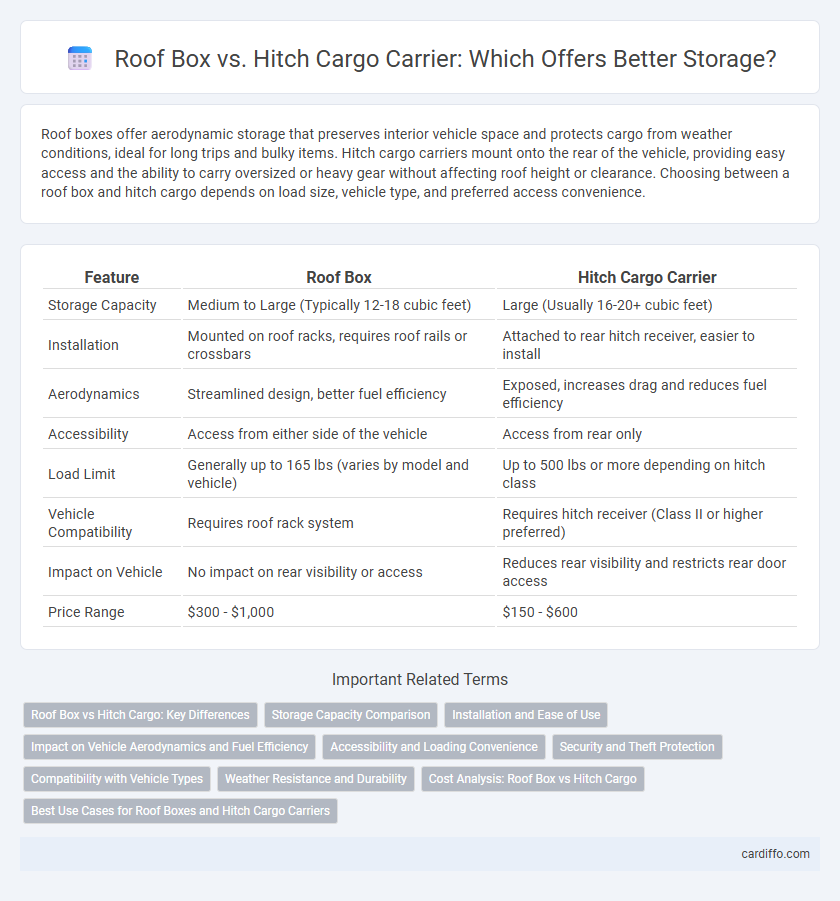Roof boxes offer aerodynamic storage that preserves interior vehicle space and protects cargo from weather conditions, ideal for long trips and bulky items. Hitch cargo carriers mount onto the rear of the vehicle, providing easy access and the ability to carry oversized or heavy gear without affecting roof height or clearance. Choosing between a roof box and hitch cargo depends on load size, vehicle type, and preferred access convenience.
Table of Comparison
| Feature | Roof Box | Hitch Cargo Carrier |
|---|---|---|
| Storage Capacity | Medium to Large (Typically 12-18 cubic feet) | Large (Usually 16-20+ cubic feet) |
| Installation | Mounted on roof racks, requires roof rails or crossbars | Attached to rear hitch receiver, easier to install |
| Aerodynamics | Streamlined design, better fuel efficiency | Exposed, increases drag and reduces fuel efficiency |
| Accessibility | Access from either side of the vehicle | Access from rear only |
| Load Limit | Generally up to 165 lbs (varies by model and vehicle) | Up to 500 lbs or more depending on hitch class |
| Vehicle Compatibility | Requires roof rack system | Requires hitch receiver (Class II or higher preferred) |
| Impact on Vehicle | No impact on rear visibility or access | Reduces rear visibility and restricts rear door access |
| Price Range | $300 - $1,000 | $150 - $600 |
Roof Box vs Hitch Cargo: Key Differences
Roof boxes offer aerodynamic storage on top of vehicles, maximizing vertical space without interfering with rear access, ideal for luggage and sports gear. Hitch cargo carriers attach to the vehicle's hitch receiver, providing easier access and supporting heavier, bulkier items but may reduce rear visibility and fuel efficiency. Choosing between roof box and hitch cargo depends on load type, vehicle design, and convenience preferences.
Storage Capacity Comparison
Roof boxes typically offer storage capacities ranging from 13 to 22 cubic feet, providing ample space for bulky items such as camping gear and sports equipment. Hitch cargo carriers generally have slightly larger capacities, often between 15 to 24 cubic feet, making them ideal for heavier or awkwardly shaped loads. Choosing between the two depends on the specific volume requirements and the type of items being transported.
Installation and Ease of Use
Roof boxes install quickly using universal clamps that secure directly to most crossbars, requiring minimal tools and effort. Hitch cargo carriers attach to the vehicle's receiver hitch, offering straightforward mounting but sometimes needing a hitch pin or lock for added security. Both options provide easy access, though roof boxes often require lifting heavier loads overhead, while hitch cargo units allow ground-level loading.
Impact on Vehicle Aerodynamics and Fuel Efficiency
Roof boxes increase vehicle drag by altering the airflow over the car's top, leading to higher fuel consumption, especially at highway speeds. Hitch cargo carriers sit lower and closer to the vehicle's rear, causing less aerodynamic disruption and usually resulting in better fuel efficiency compared to roof boxes. Choosing hitch cargo can reduce aerodynamic drag by up to 20% relative to roof-mounted storage, contributing to lower overall fuel costs.
Accessibility and Loading Convenience
Roof boxes offer easy access from above, allowing users to load and unload items without bending, ideal for lightweight gear and quick access. Hitch cargo carriers provide accessibility at vehicle height, simplifying loading of heavy or bulky items and reducing strain on the back. Both options improve storage capacity, but hitch carriers excel in loading convenience for heavier cargo due to their ergonomic position.
Security and Theft Protection
Roof boxes provide moderate security with lockable lids and weather-resistant materials, but they remain more exposed to tampering due to their elevated positioning. Hitch cargo carriers offer enhanced theft protection through integrated locking mechanisms and lower accessibility, making unauthorized removal more difficult. Investing in reinforced locks and anti-theft devices further improves security for both storage solutions.
Compatibility with Vehicle Types
Roof boxes offer broad compatibility across most vehicles with roof rails or crossbars, including sedans, SUVs, and wagons, while hitch cargo carriers depend on the presence of a trailer hitch, typically found on trucks, SUVs, and some larger vehicles. Roof boxes provide versatile storage without obstructing rear access, making them ideal for vehicles with limited towing capabilities. Hitch cargo carriers suit heavy-duty storage needs and are preferred for vehicles designed to tow, but may reduce rear visibility and limit hatch opening.
Weather Resistance and Durability
Roof boxes are typically made from high-impact ABS plastic with UV-resistant coatings, providing strong weather resistance against rain, snow, and sun exposure. Hitch cargo carriers are usually constructed from steel or aluminum with powder-coated finishes, offering superior durability and rust resistance in harsh weather conditions. Choosing between the two depends on the priority of protection against elements versus long-term structural strength.
Cost Analysis: Roof Box vs Hitch Cargo
Roof boxes generally range from $300 to $800, offering an affordable option for compact and weather-resistant storage, while hitch cargo carriers typically cost between $200 and $700, providing a sturdy solution for heavier loads. Installation costs vary; roof boxes require roof racks, adding approximately $200 to $400 if not already installed, whereas hitch cargo demands a compatible hitch receiver, averaging $300 to $500. Considering maintenance, roof boxes need regular cleaning to prevent damage from elements, whereas hitch cargo carriers may incur occasional rust treatment expenses, influencing long-term cost-effectiveness.
Best Use Cases for Roof Boxes and Hitch Cargo Carriers
Roof boxes offer optimal storage for bulky, weather-sensitive items such as camping gear and sports equipment, making them ideal for long road trips and outdoor adventures. Hitch cargo carriers excel in transporting heavy or oddly shaped goods like coolers, toolboxes, and extra luggage, providing easy access without compromising interior vehicle space. Choosing between the two depends on specific storage needs, access preferences, and vehicle compatibility.
roof box vs hitch cargo Infographic

 cardiffo.com
cardiffo.com